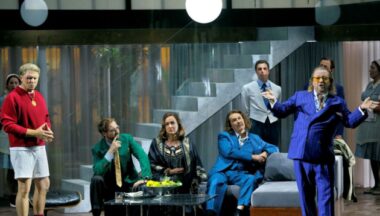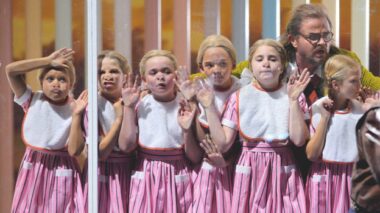
 Germany Bayreuth Festival 2022 – Wagner, Das Rheingold: Soloists, Bayreuth Festival Orchestra / Cornelius Meister (conductor). Recorded (directed by Michael Beyer) at the Bayreuth Festspielhaus and available on STAGE+ until 14.11.2047. (JPr)
Germany Bayreuth Festival 2022 – Wagner, Das Rheingold: Soloists, Bayreuth Festival Orchestra / Cornelius Meister (conductor). Recorded (directed by Michael Beyer) at the Bayreuth Festspielhaus and available on STAGE+ until 14.11.2047. (JPr)

Production:
Director – Valentin Schwarz
Designs – Andrea Cozzi
Costumes – Andy Besuch
Lighting – Reinhard Traub
Video – Luis August Krawen
Dramaturgy – Konrad Kuhn
Cast:
Wotan – Egils Silins
Donner – Raimund Nolte
Froh – Attilio Glaser
Loge – Daniel Kirch
Fricka – Christa Mayer
Freia – Elisabeth Teige
Erda – Okka von der Damerau
Alberich – Olafur Sigurdarson
Mime – Arnold Bezuyen
Fasolt – Jens-Erik Aasbø
Fafner – Wilhelm Schwinghammer
Woglinde – Lea-ann Dunbar
Wellgunde – Stephanie Houtzeel
Flosshilde – Katie Stevenson
The Broadway song that begins ‘It’s not where you start, it’s where you finish’ reflects on how I have seen Valentin Schwarz’s new Bayreuth Ring cycle. I have seen Götterdämmerung (review click here) and was unable to comment on it fully. Now I have got the opportunity thanks to STAGE+ to go back to the beginning. In this Das Rheingold I witnessed a megalomaniacal Donald Trump figure in the milieu of 1980s America (possibly because of the Dynasty-style clothes) or sometime thereafter overlording a dysfunctional family. It strongly brings to mind the sordid antics of Jeffrey Epstein and Ghislaine Maxwell with the potential victims of some child (sex?) trafficking being a gaggle of pre-pubescent children overseen by three Rhinemaiden ‘nannies’ (who may or may not provide other services for this household).
Having recently reviewed Dmitri Tcherniakov’s new Ring in Berlin where there was little shown on stage that Wagner would have recognised. Schwarz gives us absolutely nothing (at the moment) you might expect as a knowledgeable Wagnerian, or someone who has closely read the libretto. During the Prelude we see video of Wotan and Alberich (presumably) already fighting as foetuses. We then see a stage wide swimming pool with the children – if they are not just lounging around or sleeping – joining the Rhinemaidens in teasing Alberich (in brown leather jacket and jeans) who is clearly a dishevelled outcast. Because he clutches himself so often, I wonder if – like Klingsor in Parsifal – something has happened to him (though maybe chemically on this occasion).
Significant too, is the fact that the children who end up splashing water on Alberich are blonde whilst the water pistol-wielding boy (in yellow/black baseball cap and yellow T-shirt) he abducts as the Rheingold has black hair. Later we see Mime taking care of eight blonde young girls crayoning Wagnerian figures with winged helmets. These presumably will grow up to be the Valkyries, as the young boy will become the Hagen I saw in Götterdämmerung. We first meet Wotan wearing white sportswear working out with a dumbbell. It is a plush mansion with an upper level including a child’s bedroom where we can spot two photos, undoubtedly Siegmund and Sieglinde. Lower down there is Fricka in a black woollen outfit and Freia looking like a silent movie goddess. Everyone else is dressed appropriately for the time period I believe we are seeing and surrounded by Wotan’s assistant, a butler and maids; there is a broad couch, a large bookcase, drinks trolley, display case with (non-moving) snake and a Perspex box containing a pyramid glowing white which Wotan is rather connected to (representing Valhalla or Nothung?). A Rubik’s Cube also looks to be important, and Wotan plays with it from time to time, and so will Loge. Erda wears the same uniform as the Rhinemaidens but there are several indications she is Wotan’s mistress and that Fricka knows it.
The giants, Fasolt and Fafner, are gangster-types emerging from an SUV and when Wotan prevents Donner attacking them it is not with a spear but a golf club! Froh seems to be in charge of the architects plans and Loge looks the image of a shady lawyer well-versed in getting his rich client out of the holes he has dug for himself. Loge is frequently seen on his mobile phone (which tells us it certainly isn’t the 1980s), he is trying to thrash out a new deal acceptable to the giants. During his narration we see video of Wotan partying with the Rhinemaidens (with suggestions again of Epstein/Maxwell). The giants agree a new contract but go off with Freia until they get paid. Showing the effect of the loss of Freia to the family a rotten apple is perhaps the first thing in this production Wagner would smile at.

Nibelheim is a Kindergarten where the young Valkyries in candy-stripe uniforms are being schooled by Mime in his lime green suit and carrying a toy horse (Grane). High in one of the corners of the room is a CCTV camera. The boy in the gold T-shirt is there creating havoc: there will be a lot of throwing about of food and brandishing of guns and mistreatment of Mime (notably by the eight girls). For the supposed transformation into the dragon the boy has – the now-blindfolded – Alberich’s hoodie on and sits on his shoulder waving a gun. (It’s the hood that might be the Tarnhelm). Alberich is too easily captured in the end and taken back with the boy to Wotan’s mansion.
Alberich needs to make a call to Mime to bring in the ‘horde’ which is, dubiously, one of the young blonde girls. Guns are pointed at Alberich who quickly takes one off a cowardly Loge and threatens everyone with it during his curse. The girl in pink is consoled by Erda while the boy is taken by Fafner who uses a knuckleduster to kill his brother. Donner swings a golf club instead of a hammer and feigns a bad back when attempting to strike an apple. All except Wotan and Loge are fascinated by the Perspex box, whilst Loge – who now has the boy’s baseball cap – finds a gun to place on top of the box Freia looks obsessed by. (The box and gun will reappear in Die Walküre). Erda escapes with the young girl (Brünnhilde?) as Loge knocks over the drinks trolley before playing a Wagner LP on a turntable and Freia is shown putting the gun to her head. Meanwhile, Wotan is dad dancing on the upper level as the opera ends with his arms outstretched to the audience.
Musical values of this Das Rheingold – as heard through loudspeakers – did not achieve the ‘lofty heights’ of what I recently heard from Berlin. Cornelius Meister became involved in this Ring cycle at a very late stage and his reading dwelt on detail and tension; even though he seemed to – more often than some – slow things down in some places and then quicken the tempo elsewhere. (For me, there was an express lift going down and coming up from Nibelheim!) Regardless, the Bayreuth Festival Orchestra sounded their impeccable selves for him.
Egils Silins dominated this Rheingold mainly because Schwarz wants him to be such a forceful personality who believes right is on his side and he brought a declamatory approach to his Wotan. Olafur Sigurdarson was a set upon, gruff, frighteningly vehement Alberich and ideal for Schwarz’s Konzept. Christa Mayer is a known quality as a haughty Fricka, Elisabeth Teige’s voice as Freia matched her portrayal of a stronger – if clearly more troubled – character than we usually see. Daniel Kirch’s wheeler-dealing Loge was bluffer and gruffer than most, though he created a genuinely disreputable character with quirks and odd habits. Arnold Bezuyen caught the eye as the desperate, though complicit, Mime. Wilhelm Schwinghammer was a strong Fafner, whilst I have heard Fasolt (Jens-Erik Aasbø), Donner (Raimund Nolte) and Froh (Attilio Glaser) performed better in the past. The trio of Rhinemaidens (Lea-ann Dunbar, Stephanie Houtzeel and Katie Stevenson) were melodious, provocative and vicious. It is odd that the best singing was in the shortest role, with Okka von der Damerau mightily impressive as Erda and singing with warm, rich timbre and great authority.
Jim Pritchard
